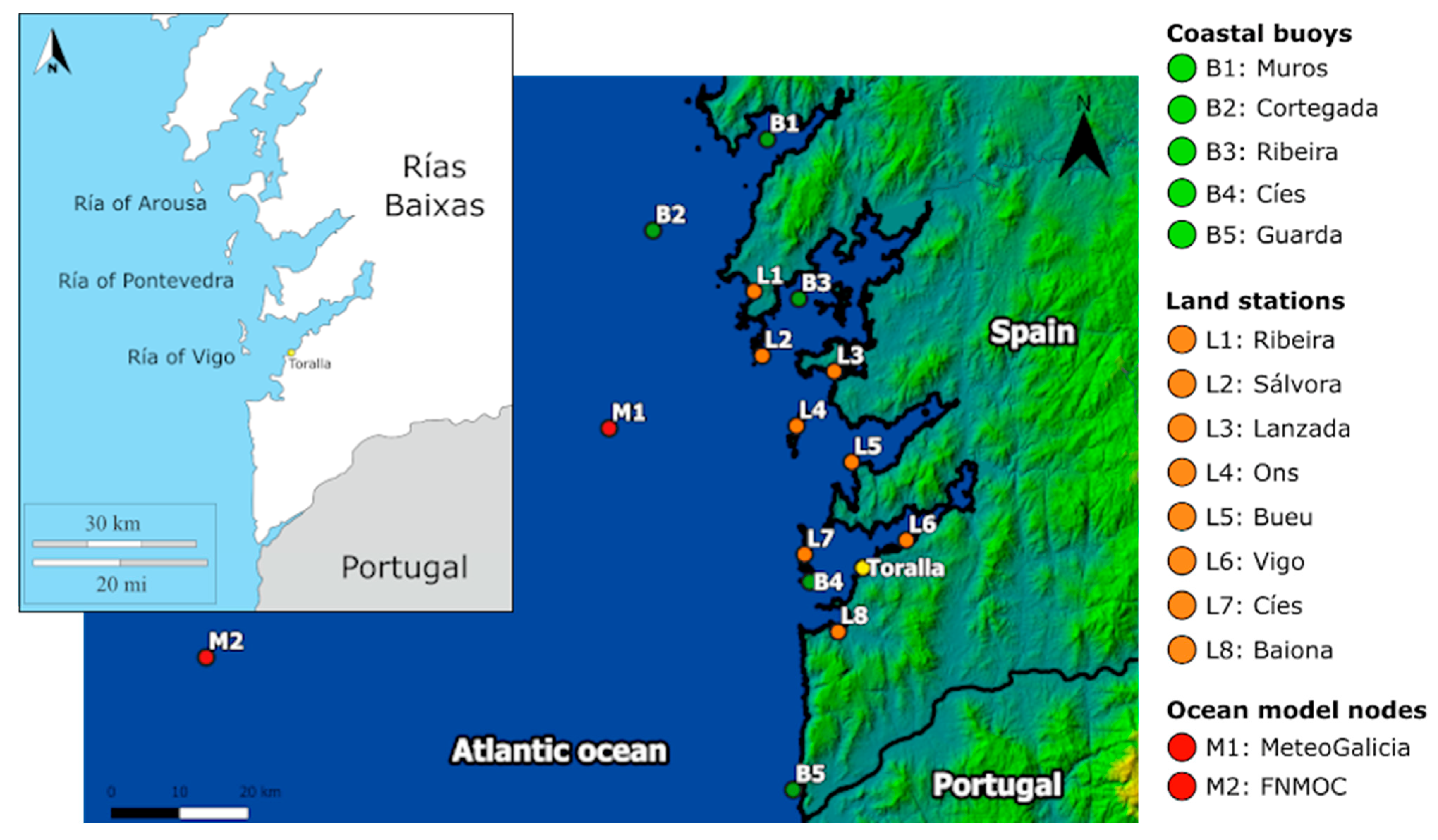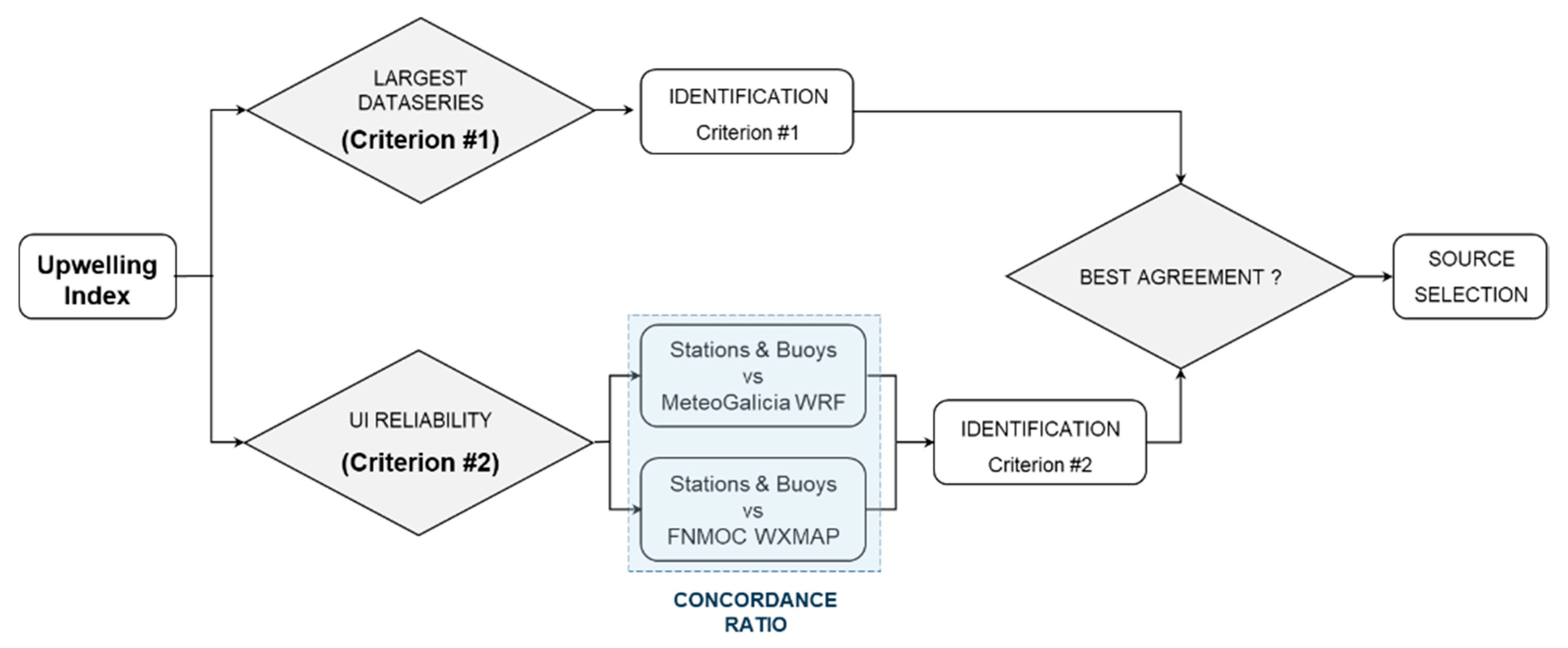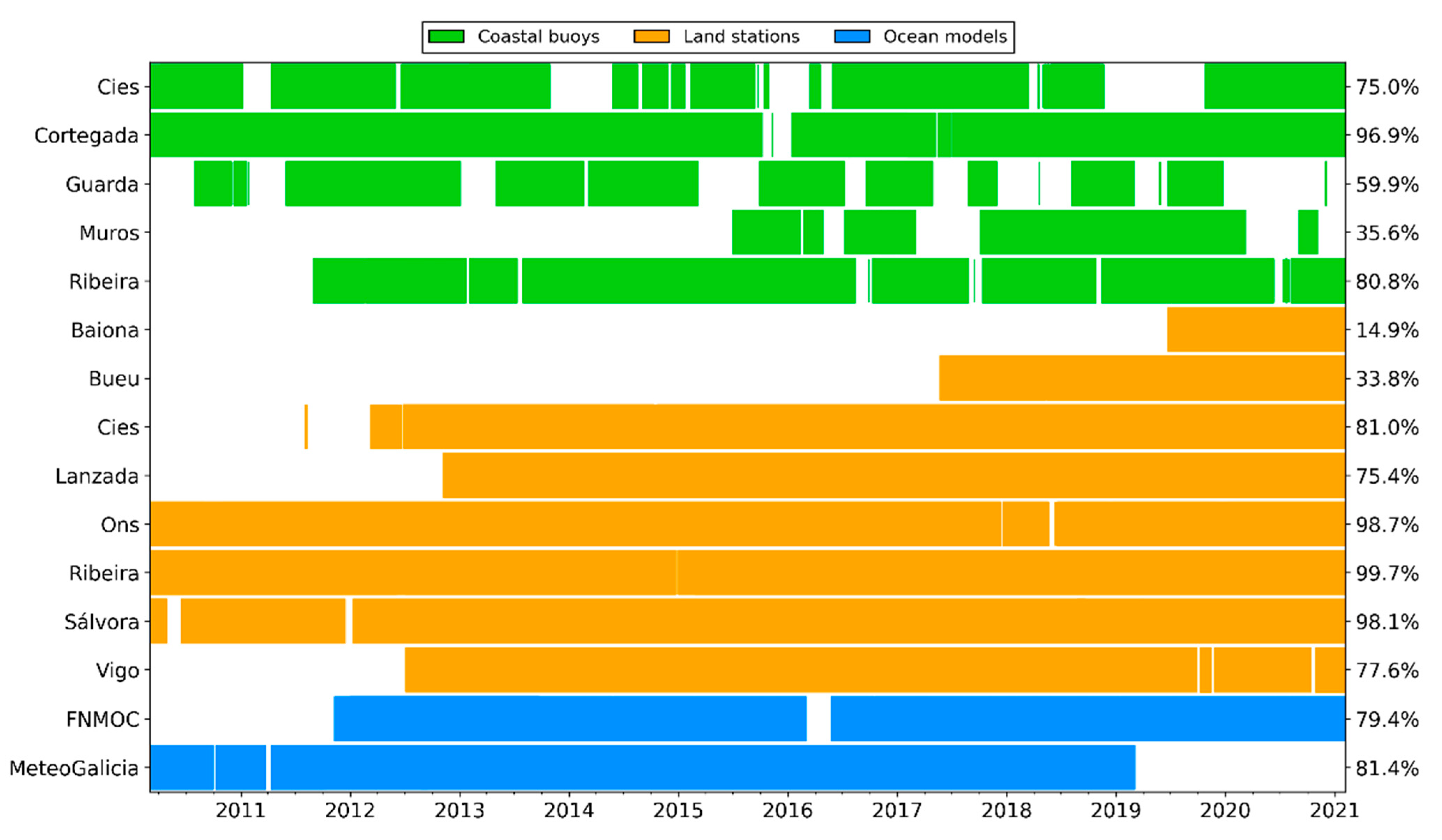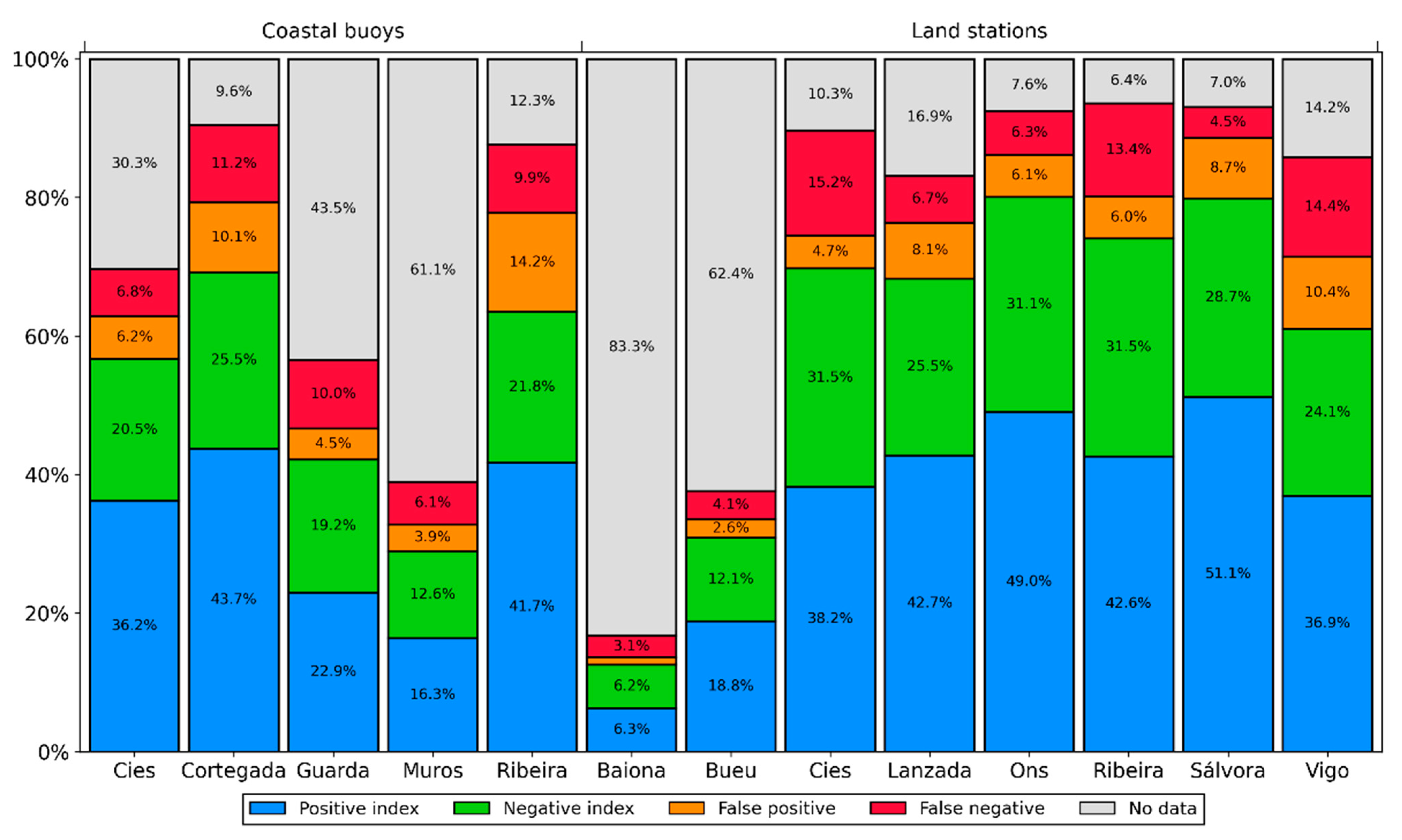Reliability of Using Meteorological Data to Estimate Upwelling Events on the Galician Coast
Abstract
:1. Introduction
2. Materials and Methods
2.1. Available Data Sources
- Toralla station. The ECIMAT has its own automatic ocean-meteorological observation station, located at the floating end of the mooring pontoon used by the center’s vessels. The sensors were installed in November 2012, with the testing period ending in June 2013. The meteorological monitoring set has an ambient temperature and humidity sensor, anemometer (speed and direction for sustained wind and gusts) and pyranometer (solar irradiance), located 3.1 m above the floating surface of the pontoon. The oceanographic part has sensors for temperature, conductivity, dissolved oxygen concentration and salinity, all recording measurements at a depth of 1 m below the sea surface. All sensors record data at a ten-minute frequency. Access to the station’s measurement history is possible through the repository published in the Pangaea portal [41]. The data are available under Creative Commons license, and can be used, adapted and redistributed free of charge. Uploading new records to the public repository requires prior pre-processing and validation of the data, which results in a low update frequency. At the time of writing, the period of available data spans from June 2013 (August for oceanographic data) to December 2019.
- Coastal buoys. Offshore ocean-meteorological monitoring stations of the Regional Weather Forecast Agency MeteoGalicia located along the Rías Baixas coastline. Their installation and commissioning dates back between 2007 and 2015. All six buoys and platforms have meteorological sensors for ambient temperature, dew temperature and air humidity, as well as anemometers (with the exception of the Rande buoy) to record sustained and gust wind speed and direction. Most sites also have oceanographic probes for temperature, salinity, conductivity and density anomaly below the sea surface, at a depth of 1.5 m in most cases. Besides, some of the buoys have additional sensors for dissolved oxygen concentration, water column pressure, or north and east components of underwater current velocity. All observations are recorded at a ten-minute frequency.
- Land stations. MeteoGalicia also has a network of more than 160 automated land-based weather observation stations, making it the densest meteorological network available for the Region of Galicia. Of all the stations currently active, eight are located on the coast of the Rías Baixas, in locations that allow the wind regimes entering the Vigo estuary from the Atlantic to be captured without suffering significant interference from the inland orography (see Figure 1). The start of the operational period of the eight selected stations is between 2000 and 2019. All of these stations have sustained wind speed and direction sensors. Most of them are also capable of measuring ambient temperature and humidity, solar irradiance, precipitation and wind gusts. The measurements are always at a ten-minute frequency, as in the case of coastal buoys.
- Mesoscale numerical model Weather Research and Forecasting (WRF) operated by MeteoGalicia: This model integrates meteorological observations taken at points scattered across the geography of the study region, as well as numerical estimates generated by other forecasting models of global scope and lower spatial resolution. In the specific case of the MeteoGalicia model, the Global Forecast System (GFS) model of the National Oceanic and Atmospheric Administration (NOAA) is used as input. The integrated input data are processed to solve fluid-dynamic differential equations that model the behavior of the Earth’s atmosphere on a regional scale. This modelling covers a limited part of the atmosphere divided into three-dimensional grids, over a time range also divided into discrete time steps. The result of these calculations is a set of forward estimates for different meteorological variables at the central points of each of the three-dimensional cells into which the region under study is divided, for each of the defined time steps.
- Global & Regional Weather Prediction Charts (WXMAP) dataset: This forecast ensemble is generated from the Navy Global Environmental Model (NAVGEM), a global-scale numerical weather model operated by the US-based Fleet Numerical Meteorology and Oceanography Center (FNMOC). The operational fundamentals of the NAVGEM model are very similar to those of the GFS model, both differing from the WRF model in that they are global in scope and therefore simulate the behavior of the Earth’s atmosphere for the entire planet.
2.2. Methodology
2.2.1. Ekman Transport and Upwelling Index
2.2.2. Data Processing. Evaluation Metrics
2.2.3. Data Source Selection
3. Results and Discussion
3.1. Complience with Criterion 1
3.2. Complience with Criterion 2
3.3. Criteria Agreement and Source Selection
4. Conclusions
- The station on the Ons islands achieves a high level of agreement with the upwelling index historical records of the available numerical models.
- The station on the island of Sálvora also characterizes the oceanic wind regime with a high level of accuracy.
- Both stations offer free, reliable, and near-real-time information.
- The use of these stations allows solving the problems related to the operational use of the historical upwelling index series provided by the Spanish Institute of Oceanography.
- Both stations can be used to characterize the occurrence of upwelling periods on Toralla Island.
Author Contributions
Funding
Institutional Review Board Statement
Informed Consent Statement
Data Availability Statement
Conflicts of Interest
References
- Lavín, A.; del Río, G.D.; Cabanas, J.M.; Casas, G. Índices de Afloramiento Para el Punto 43° N 11° W.; Período 1966–1989; Instituto Español de Oceanografía: Madrid, Spain, 1991; Volume 91. [Google Scholar]
- Álvarez Fernández, M.I. Caracterización de un Episodio de Afloramiento Invernal en la ría de Pontevedra; Vigo, Spain, 2002; pp. 1–84. [Google Scholar]
- Benazzouz, A.; Mordane, S.; Orbi, A.; Chagdali, M.; Hilmi, K.; Atillah, A.; Pelegrí, J.L.; Hervé, D. An improved coastal upwelling index from sea surface temperature using satellite-based approach—The case of the Canary Current upwelling system. Cont. Shelf Res. 2014, 81, 38–54. [Google Scholar] [CrossRef]
- Ryther, J.H. Photosynthesis and fish production in the sea. Science 1696, 166, 72–80. [Google Scholar] [CrossRef] [PubMed] [Green Version]
- Cushing, D.H. Upwelling and the Production of Fish. Adv. Mar. Biol. 1971, 9, 255–334. [Google Scholar]
- Fréon, P.; Barange, M.; Aristegui, J. Eastern Boundary Upwelling Ecosystems: Integrative and comparative approaches. Prog. Oceanogr. 2009, 83, 1–14. [Google Scholar] [CrossRef]
- Fernández, E.; Álvarez-Salgado, X.A.; Beiras, R.; Ovejero, A.; Méndez, G. Coexistence of urban uses and shellfish production in an upwelling-driven, highly productive marine environment: The case of the Ría de Vigo (Galicia, Spain). Reg. Stud. Mar. Sci. 2016, 8, 362–370. [Google Scholar] [CrossRef] [Green Version]
- Alvarez, I.; Gomez-Gesteira, M.; deCastro, M.; Novoa, E.M. Ekman transport along the Galician Coast (NW, Spain) calculated from QuikSCAT winds. J. Mar. Syst. 2008, 72, 101–115. [Google Scholar] [CrossRef]
- Pérez-Alberti, A.; Pires, A.; Freitas, L.; Chaminé, H. Shoreline change mapping along the coast of Galicia, Spain. Proc. Inst. Civ. Eng. Marit. Eng. 2013, 166, 125–144. [Google Scholar] [CrossRef]
- Von Richthofen, F. Führer für Forschungsreisende; Verlag Robert Oppenheim: Berlin, Germany, 1886. [Google Scholar]
- Barton, E.D.; Largier, J.L.; Torres, R.; Sheridan, M.; Trasviña, A.; Pazos, Y.; Valle-Levinson, A. Coastal upwelling and downwelling forcing of circulation in a semi-enclosed bay: Ria de Vigo. Prog. Oceanogr. 2015, 134, 173–189. [Google Scholar] [CrossRef] [Green Version]
- Arístegui, J.; Barton, E.D.; Álvarez-Salgado, X.A.; Santos, A.M.P.; Figueiras, F.G.; Kifani, S.; Hernández-León, S.; Mason, E.; Machú, E.; Demarcq, H. Sub-regional ecosystem variability in the Canary Current upwelling. Prog. Oceanogr. 2009, 83, 33–48. [Google Scholar] [CrossRef] [Green Version]
- Prego, R.; Bao, R. Upwelling influence on the Galician coast: Silicate in shelf water and underlying surface sediments. Cont. Shelf Res. 1997, 17, 307–318. [Google Scholar] [CrossRef] [Green Version]
- Enriquez, A.G.; Friehe, C.A. Effects of Wind Stress and Wind Stress Curl Variability on Coastal Upwelling. J. Phys. Oceanogr. 1995, 25, 1651–1671. [Google Scholar] [CrossRef]
- Dorman, C.E.; Holt, T.; Rogers, D.P.; Edwards, K. Large-Scale Structure of the June–July 1996 Marine Boundary Layer along California and Oregon. Mon. Weather. Rev. 2000, 128, 1632–1652. [Google Scholar] [CrossRef]
- Edwards, K.A.; Rogerson, A.M.; Winant, C.D.; Rogers, D.P. Adjustment of the marine atmospheric boundary layer to a Coastal Cape. J. Atmos. Sci. 2001, 58, 1512–1528. [Google Scholar] [CrossRef]
- Perlin, N.; Samelson, R.M.; Chelton, D.B. Scatterometer and model wind and wind stress in the Oregon–Northern California Coastal Zone. Mon. Weather Rev. 2004, 132, 2110–2129. [Google Scholar] [CrossRef]
- Aguilera, V.M.; Escribano, R.; Vargas, C.A.; González, M.T. Upwelling modulation of functional traits of a dominant planktonic grazer during “warm-acid” El Niño 2015 in a year-round upwelling area of Humboldt Current. PLoS ONE 2019, 14, e0209823. [Google Scholar] [CrossRef] [PubMed] [Green Version]
- Leitão, F.; Baptista, V.; Vieira, V.; Silva, P.L.; Relvas, P.; Teodósio, M.A. A 60-Year Time Series Analyses of the Upwelling along the Portuguese Coast. Water 2019, 11, 1285. [Google Scholar] [CrossRef] [Green Version]
- Mercado, J.; León, P.; Salles, S.; Cortés, D.; Yebra, L.; Gómez-Jakobsen, F.; Herrera, I.; Alonso, A.; Sánchez, A.; Valcárcel-Pérez, N.; et al. Time Variability Patterns of Eutrophication Indicators in the Bay of Algeciras (South Spain). Water 2018, 10, 938. [Google Scholar] [CrossRef] [Green Version]
- Dabuleviciene, T.; Kozlov, I.E.; Vaiciute, D.; Dailidiene, I. Remote Sensing of Coastal Upwelling in the South-Eastern Baltic Sea: Statistical Properties and Implications for the Coastal Environment. Remote Sens. 2018, 10, 1752. [Google Scholar] [CrossRef] [Green Version]
- Goela, P.C.; Cordeiro, C.; Danchenko, S.; Icely, J.; Cristina, S.; Newton, A. Time series analysis of data for sea surface temperature and upwelling components from the southwest coast of Portugal. J. Mar. Syst. 2016, 163, 12–22. [Google Scholar] [CrossRef] [Green Version]
- Nascimento, S.; Franco, P.; Sousa, F.; Dias, J.; Neves, F. Automated computational delimitation of SST upwelling areas using fuzzy clustering. Comput. Geosci. 2012, 43, 207–216. [Google Scholar] [CrossRef]
- Jing, Z.; Qi, Y.; Hua, Z.; Zhang, H. Numerical study on the summer upwelling system in the northern continental shelf of the South China Sea. Cont. Shelf Res. 2009, 29, 467–478. [Google Scholar] [CrossRef]
- Pardo, P.C.; Padín, X.A.; Gilcoto, M.; Farina-Busto, L.; Pérez, F.F. Evolution of upwelling systems coupled to the long-term variability in sea surface temperature and Ekman transport. Clim. Res. 2011, 48, 231–246. [Google Scholar] [CrossRef] [Green Version]
- Kok, P.H.; Akhir, M.F.M.; Tangang, F.; Husain, M.L. Spatiotemporal trends in the southwest monsoon wind-driven upwelling in the southwestern part of the South China Sea. PLoS ONE 2017, 12, e0171979. [Google Scholar] [CrossRef] [PubMed] [Green Version]
- Sousa, F.M.; Nascimento, S.; Casimiro, H.; Boutov, D. Identification of upwelling areas on sea surface temperature images using fuzzy clustering. Remote Sens. Environ. 2008, 112, 2817–2823. [Google Scholar] [CrossRef]
- Astudillo, O.; Dewitte, B.; Mallet, M.; Rutllant, J.A.; Goubanova, K.; Frappart, F.; Ramos, M.; Bravo, L. Sensitivity of the Near-Shore Oceanic Circulation Off Central Chile to Coastal Wind Profiles Characteristics. J. Geophys. Res. Oecans 2019, 124, 4644–4676. [Google Scholar] [CrossRef]
- Froján, M.; Castro, C.G.; Zúñiga, D.; Arbones, B.; Alonso-Pérez, F.; Figueiras, F.G. Mussel farming impact on pelagic production and respiration rates in a coastal upwelling embayment (Ría de Vigo, NW Spain. Estuar. Coast. Shelf Sci. 2018, 204, 130–139. [Google Scholar] [CrossRef]
- Alvarez, I.; Gomez-Gesteira, M.; deCastro, M.; Prego, R. Variation in upwelling intensity along the NorthWest Iberian Peninsula (Galicia). J. Atmos. Ocean Sci. 2005, 10, 309–324. [Google Scholar] [CrossRef]
- Jayaram, C.; Kumar, P.K.D. Spatio-temporal variability of upwelling along the southwest coast of India based on satellite observations. Cont. Shelf Res. 2018, 156, 33–42. [Google Scholar] [CrossRef]
- Dunbar, S.; Weiss, B.; Stiles, B.; Huddleston, J.; Callahan, P.; Callahan, P.; Perry, K.L.; Hsu, C. QuikSCAT Science Data Product User’s Manual; Lungu, T., Ed.; JPL: Pasadena, CA, USA, 2006. [Google Scholar]
- Torres, R.; Barton, E.D.; Miller, P.; Fanjul, E. Spatial patterns of wind and sea surface temperature in the Galician upwelling region. J. Geophys. Res. 2003, 108. [Google Scholar] [CrossRef] [Green Version]
- Prego, R.; Varela, M.; deCastro, M.; Ospina-Alvarez, N.; Garcia-Soto, C.; Gómez-Gesteira, M. The influence of summer upwelling at the western boundary of the Cantabrian coast. Estuar. Coast. Shelf Sci. 2012, 98, 138–144. [Google Scholar] [CrossRef] [Green Version]
- Sousa, M.; Alvarez, I.; Vaz, N.; Dias, J. Evaluating QuikSCAT wind data to study wind induced coastal phenomena along the Galician Coast. J. Coast. Res. 2011, 64, 445–449. [Google Scholar]
- Accadia, C.; Zecchetto, S.; Lavagnini, A.; Speranza, A. Comparison of 10-m Wind Forecasts from a Regional Area Model and QuikSCAT Scatterometer Wind Observations over the Mediterranean Sea. Mon. Weather Rev. 2007, 135, 1945–1960. [Google Scholar] [CrossRef]
- Sánchez, R.F.; Relvas, P.; Pires, H.O. Comparisons of ocean scatterometer and anemometer winds off the southwestern Iberian Peninsula. Cont. Shelf Res. 2007, 27, 155–175. [Google Scholar] [CrossRef]
- Alvarez-Salgado, X.A.; Gago, J.; Míguez, B.M.; Gilcoto, M.; Pérez, F.F. Surface waters of the NW Iberian margin: Upwelling on the shelf versus outwelling of upwelled waters from the Rías Baixads. Estuar. Coast. Shelf Sci. 2000, 51, 821–837. [Google Scholar] [CrossRef] [Green Version]
- Gomez-Gesteira, M.; Moreira, C.; Alvarez, I.; deCastro, M. Ekman transport along the Galician coast (northwest Spain) calculated from forecasted winds. J. Geophys. Res. 2006, 111. [Google Scholar] [CrossRef]
- Torres-Palenzuela, J.M.; Vilas, L.G.; Bellas, F.M.; Garet, E.; González-Fernández, Á.; Spyrakos, E. Pseudo-nitzschia Blooms in a Coastal Upwelling System: Remote Sensing Detection, Toxicity and Environmental Variables. Water 2019, 11, 1954. [Google Scholar] [CrossRef] [Green Version]
- González, J.; Herrera, J.L.; Varela, R.A. CIM-ECIMAT Ocean Meteorological Station Time-Series—Wind Data. PANGAEA 2020. [Google Scholar] [CrossRef]
- MeteoGalicia. Estacións Océano-Meteorolóxicas. 2022. Available online: http://www2.meteogalicia.gal/galego/observacion/plataformas/plataformas.asp (accessed on 20 September 2022).
- MeteoGalicia. Rede Meteorolóxica. 2022. Available online: https://www.meteogalicia.gal/observacion/estacions/estacions.action (accessed on 20 September 2022).
- Ekman, V.W. On the influence of the Earth’s rotation on ocean-currents. Ark. För Mat. Astron. Och Fys. 1905, 2, 52. [Google Scholar]
- Blanton, J.O.; Atkinson, L.P.; Castillejo, F.; Lavín, A. Coastal upwelling off the Rias Bajas, Galicia, Northwest Spain. I. Hydrogrophic Studies. Réunion Du Cons. Int. Explor. Mer 1984, 183, 79–90. [Google Scholar]





| Name | Source Type | Distance to ECIMAT [km] | Data Record | Real Time | Direct UI |
|---|---|---|---|---|---|
| Toralla | L | 0.2 | 2013– | - | - |
| MeteoGalicia WRF | M | 42.6 | 2010–2019 | - | Yes |
| FNMOC WXMAP | M | 102.7 | 2011–2021 | - | Yes |
| Cíes buoy | B | 7.9 | 2008– | Yes | - |
| Rande buoy | B | 15.0 | 2007– | Yes | - |
| Guarda buoy | B | 33.9 | 2010– | Yes | - |
| Ribeira buoy | B | 40.6 | 2011– | Yes | - |
| Cortegada platform | B | 47.3 | 2007– | Yes | - |
| Muros buoy | B | 64.6 | 2015– | Yes | - |
| Vigo station | L | 7.6 | 2012– | Yes | - |
| Cíes station | L | 8.9 | 2012– | Yes | - |
| Baiona station | L | 9.9 | 2019– | Yes | - |
| Bueu station | L | 15.8 | 2017– | Yes | - |
| Ons station | L | 23.1 | 2005– | Yes | - |
| Lanzada station | L | 29.2 | 2012– | Yes | - |
| Sálvora station | L | 34.5 | 2006– | Yes | - |
| Ribeira station | L | 43.5 | 2000– | Yes | - |
| Group | Category | Buoy/Station UI Value | Model UI Value |
|---|---|---|---|
| Concordance | Positive index (PI) | + | + |
| Negative index (NI) | − | − | |
| Divergence | False positive (FP) | + | − |
| False negative (FN) | − | + | |
| No data | N/A | N/A |
| Source Name | Type | CR (vs. MeteoGalicia) | CR (vs. FNMOC) |
|---|---|---|---|
| Cíes | B | 0.731 | 0.813 |
| Cortegada | B | 0.685 | 0.765 |
| Guarda | B | 0.684 | 0.744 |
| Muros | B | 0.638 | 0.743 |
| Ribeira | B | 0.623 | 0.725 |
| Baiona | L | - | 0.749 |
| Bueu | L | 0.689 | 0.822 |
| Cies | L | 0.713 | 0.778 |
| Lanzada | L | 0.695 | 0.822 |
| Ons | L | 0.765 | 0.866 |
| Ribeira | L | 0.713 | 0.793 |
| Sálvora | L | 0.734 | 0.858 |
| Vigo | L | 0.632 | 0.711 |
Publisher’s Note: MDPI stays neutral with regard to jurisdictional claims in published maps and institutional affiliations. |
© 2022 by the authors. Licensee MDPI, Basel, Switzerland. This article is an open access article distributed under the terms and conditions of the Creative Commons Attribution (CC BY) license (https://creativecommons.org/licenses/by/4.0/).
Share and Cite
Pérez-Orozco, R.; López-Gómez, J.; Eguía-Oller, P.; López-Pérez, J.; de la Huz, R.; Granada-Álvarez, E.; Cerviño-Rodríguez, R. Reliability of Using Meteorological Data to Estimate Upwelling Events on the Galician Coast. Water 2022, 14, 3387. https://doi.org/10.3390/w14213387
Pérez-Orozco R, López-Gómez J, Eguía-Oller P, López-Pérez J, de la Huz R, Granada-Álvarez E, Cerviño-Rodríguez R. Reliability of Using Meteorological Data to Estimate Upwelling Events on the Galician Coast. Water. 2022; 14(21):3387. https://doi.org/10.3390/w14213387
Chicago/Turabian StylePérez-Orozco, Raquel, Javier López-Gómez, Pablo Eguía-Oller, Jesús López-Pérez, Rosario de la Huz, Enrique Granada-Álvarez, and Rodrigo Cerviño-Rodríguez. 2022. "Reliability of Using Meteorological Data to Estimate Upwelling Events on the Galician Coast" Water 14, no. 21: 3387. https://doi.org/10.3390/w14213387





